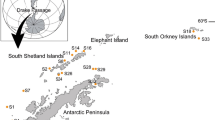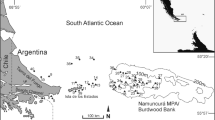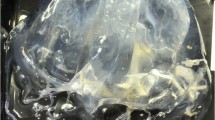Abstract
Predator holes in empty shells of Joania cordata and Argyrotheca cuneata (Brachiopoda: Megathyrididae) collected in the marine protected area “Secche di Tor Paterno”, central Tyrrhenian Sea, Italy (41°35′N–12°20′E, at depths of 20–28 m), were analyzed. Predation intensity was low but appreciable, with the more common species J. cordata preyed on more frequently (6.7 %) than A. cuneata (3.8 %). Three main types of holes were recognized: (1) cylindrical drill holes with a circular outline, (2) larger irregular holes with a jagged outline, and (3) small holes at the bottom of depressions in the shell. They were probably produced by muricid gastropods, crabs, and Foraminifera, respectively. The large, irregular holes were the most common type in both brachiopod species. Evidence for predator selectivity with respect to which valve, the position of the hole on the valve, and the size of the brachiopod with respect to those available was assessed. The ventral valve, the postero-medial portions of both valves, and larger (J. cordata) or medium-sized (A. cuneata) shells were more frequently holed.




Similar content being viewed by others
References
Aberhan M, Kiessling W, Fürsich FT (2006) Testing the role of biological interactions for the evolution in mid-Mesozoic marine benthic ecosystems. Paleobiology 32:259–277
Albano PG, Sabelli B (2011) Comparison between death and living molluscs assemblages in a Mediterranean infralittoral off-shore reef. Palaeogeogr Palaeoclimatol Palaeoecol 310:206–215
Alvarez F, Taylor PD (1987) Epizoan ecology and interactions in the Devonian of Spain. Palaeogeogr Palaeoclimatol Palaeoecol 61:17–31
Ameyaw-Akumfi C, Hughes RN (1987) Behaviour of Carcinus maenas feeding on large Mytilus edulis. How do they assess the optimal diet? Mar Ecol 38:213–216
Asgaard U, Bromley RG (1990) Colonization by micromorph brachiopods in the shallow subtidal of the eastern Mediterranean Sea. In: MacKinnon DI, Lee DE, Campbell JD (eds) Brachiopods through time. Balkema, Rotterdam, pp 261–264
Asgaard U, Stentoft N (1984) Recent micromorphic brachiopods from Barbados: paleoecological and evolutionary implications. Geobiol 17:29–37
Barnes DKA, Peck LS (1996) Epibiota and attachment substrata of deep-water brachiopods from Antarctica and New Zealand. Philos Trans R Soc Lond 351:677–687
Baumiller TK, Bitner MA (2004) A case of intense predatory drilling of brachiopods from the middle Miocene of southeastern Poland. Palaeogeogr Palaeoclimatol Palaeoecol 214:85–96
Baumiller TK, Kowalewski M, Deline BL, Hoffmeister AP, Améziane N, Eléaume M, D’Hondt JL (2003) Drillholes in extant brachiopods and their implications for the history of predation. Geol Soc Amer, Abstracts with Programs, pp. 35–7
Baumiller TK, Bitner MA, Emig CC (2006) High frequency of drill holes in brachiopods from the Pliocene of Algeria and its ecological implications. Lethaia 39:313–320
Beuck L, López Correa M, Freiwald A (2008) Biogeographical distribution of Hyrrokkin (Rosalinidae, Foraminifera) and its host-specific morphological and textural trace variability. In: Wisshak M, Tapanila M (eds) Current developments in bioerosion. Berlin, Heidelberg, pp 329–360
Bitner MA (2010) Biodiversity of shallow-water brachiopods from New Caledonia, SW Pacific, with description of a new species. Sci Mar 74:643–657
Bourdeau PE, O’Connor NJ (2003) Predation by the nonindigenous Asian shore crab Hemigrapsus sanguineus on macroalgae and molluscs. Northeast Nat 10:319–334
Bromley RG (1981) Concepts in ichnotaxonomy illustrated by small round holes in shells. Acta Geol Hisp 16:55–64
Bromley RG (1993) Predation habits of Octopus past and present and a new ichnospecies, Oichnus ovalis. Bull Geol Soc Den 40:167–173
Browne DW, Berkman PA (1992) Epizooic foraminifera, tanaid, and polychaete species associations on Antarct scallop shells. Antarct J US 27:134–135
Carriker MR (1981) Shell penetration and feeding by naticacean and muricacean predatory gastropods: a synthesis. Malacol 20:403–422
Cedhagen T (1994) Taxonomy and biology of Hyrrokkin sarcophaga gen. et sp. n., a parasitic foraminiferan (Rosalinidae). Sarsia 79:65–82
Delance JH, Emig CC (2004) Drilling predation on Gryphus vitreus (Brachiopoda) off the French Mediterranean coasts. Palaeogeogr Palaeocilmatol Palaeoecol 208:23–30
Deline B, Baumiller TK, Kaplan P, Kowalewski M, Hoffmeister AP (2003) Edge-drilling on the brachiopod Perditocardinia cf. P. dubia from the Mississippian of Missouri (USA). Palaeogeogr Palaeoclimatol Palaeoecol 201:211–219
Donovan SK, Gale AS (1990) Predatory asteroids and the decline of the articulate brachiopods. Lethaia 23:77–86
Emig CC (1989) Distributional patterns along the Mediterranean continental margin (upper bathyal) using Gryphus vitreus (Brachiopoda) densities. Palaeogeogr Palaeoclimatol Palaeoecol 71:253–256
Evangelisti F, Albano PG, Sabelli B (2011) Recent brachiopoda of the marine protected area “Secche di Tor Paterno”, central Tyrrheniana Sea. Cah Biol Mar 52:193–202
Gili JM, Arntz WE, Palanques A, Orejas C, Clarke A, Dayton PK et al (2006) A unique assemblage of epibenthic sessile suspension feeders with archaic features in the high-Antarctic. Deep-Sea Res II 53:1029–1052
Gould SJ, Calloway BC (1980) Clams and brachiopods ships that pass in the night. Paleobiology 6:383–396
Hammer O, Harper DAT, Ryan PD (2001) PAST: paleontological statistics software package for education and data analysis. Palaeontol Electron 4:9
Harper EM (2005) Evidence of predation damage in Pliocene Apletosia maxima (Brachiopoda). Palaeontol 48:197–208
Harper EM (2011) What do we really know about predation on modern rhynchonelliforms? Mem Assoc Australas Palaeontol 41:45–57
Harper EM, Peck L (2003) Predatory behavior and metabolic costs in the Antarctic muricid gastropod Trophon longstaffi. Polar Biol 26:208–217
Harper EM, Wharton DS (2000) Boring predation and mesozoic articulate brachiopods. Palaeogeogr Palaeoclimatol Palaeoecol 158:15–24
Harper EM, Forsythe GTW, Palmer T (1998) Taphonomy and the mesozoic marine revolution: preservation state masks the importance of boring predators. Palaios 13:352–360
Harper EM, Robinson JH, Lee DE (2011) Drill holes analysis reveals evidence of targeted predation on modern brachiopods. Palaeogeogr Palaeoclimatol Palaeoecol 305:162–171
Hoffmeister AP, Kowalewski M, Bambach RK, Baumiller TK (2003) Intense drilling in the carboniferous brachiopod Cardiarina cordata Cooper, 1956. Lethaia 36:107–118
Hoffmeister AP, Kowalewski M, Baumiller TK, Bambach RK (2004) Drilling predation on Permian brachiopods and bivalves from the Glass Mountains, west Texas. Acta Palaeoentol Pol 49:443–454
James MS, Ansell AD, Collins MJ, Curry GB, Peck LS, Rhodes MC (1992) Recent advances in the study of living brachiopods. Adv Mar Biol 28:175–387
Jonkers HA (2000) Gastropod predation patterns in Pliocene and Recent pectinid bivalves from Antarctica and New Zealand. NZ J Geol Geophys 43:247–254
Juanes F (1992) Why do deacapod crustaceans prefer small-sized molluscan prey? Mar Ecol 87:239–249
Kabat AR (1990) Predatory ecology of naticid gastropods with a review of shell boring predation. Malacol 32:155–193
Kelley PH, Hansen TA (2003) The fossil record of drilling predation on bivalves and gastropods. In: Kelley PH, Kowalewski M, Hansen TA (eds) Predator–prey interactions in the fossil record, topics in geobiology. Kluwer, New York, pp 113–139
Kowalewski M (1993) Morphometric analysis of predatory drill-holes. Palaeogeogr Palaeoclimatol Palaeoecol 102:69–88
Kowalewski M (2002) The fossil record of predation: an overview of analytical methods. In: Kowalewski M, Kelley PH (ed) The fossil record of predation, Paleontological society special papers, Yale University Press, New Haven, Connecticut, pp 3–42
Kowalewski M, Flessa KW, Marcot JD (1997) Predatory scars in the shells of a recent lingulid brachiopod: paleontological and ecological implications. Acta Palaeontol Pol 42:497–532
Kowalewski M, Dulai A, Fürsich FT (1998) A fossil record full of holes: the phanerozoic history of drilling predation. Geology 26:1091–1094
Kowalewski M, Simões MG, Carroll M, Rodland DL (2002) Abundant brachiopods on a tropical, upwelling-influenced shelf (Southeast Brazilian Bight, South Atlantic). Palaios 17:277–286
Kowalewski M, Hoffmeister AP, Baumiller TK, Bambach RK (2005) Secondary evolutionary escalation between brachiopods and enemies of other prey. Sci 308:1774–1777
Lee DE (2008) The terebratulides: the supreme brachiopod survivors. Foss Strat 54:241–249
Leighton LR (1999) Possible latitudinal predation gradient in Middle Paleozoic oceans. Geology 27:47–50
Leighton LR (2002) Inferring predation intensity in the marine fossil record. Paleobiology 28:328–342
Lipps JH (1983) Biotic interactions in benthic Foraminifera. In: Tevesz MJS, McCall PL (eds) Biotic interactions in recent and fossil benthic communities. Plenum Press, New York, pp 331–376
Logan A, Tomasových A, Zuschin M, Grill B (2008) Recent brachiopods from the Red Sea and Gulf of Aden. Foss Strat 54:299–309
Mahon AR, Amsler CD, McClintock JB, Amsler MO, Baker BJ (2003) Tissue-specific palatability and chemical defenses against macropredators and pathogens in the common articulate brachiopod Liothyrella uva from the Antarctic Peninsula. J Exp Mar Biol Ecol 290:197–210
McClintock JB, Slattery M, Thayer CW (1993) Energy content and chemical defense of the articulate brachiopod Liothyrella uva (Jackson, 1912) from the Antarctic Peninsula. J Exp Mar Biol Ecol 169:103–116
Morton B, Harper EM (2008) Predation upon Mytilus galloprovincialis (Mollusca: Bivalvia: Mytilidae) by juvenile Carcinus maenas (Crustacea: Decapoda) using mandibular chipping. J Mar Biol Assess UK 88:563–568
Noble JPA, Logan A, Webb GR (1976) The recent Terebratulina community in the rocky subtidal zone of the Bay of Fundy, Canada. Lethaia 9:1–17
Olszewski T, Erwin DH (2004) Dynamic response of Permian brachiopod communities to long-term environmental change. Nature 428:738–741
Paine RT (1969) Growth and size distribution of the brachiopod Terebratalia transversa Sowerby. Pac Sci 23:337–343
Peck LS (1993) The tissues of articulate brachiopods and their value to predators. Phil Trans R Soc Lond 339:17–32
Peck LS, Barnes DKA, Willmott J (2005) Responses to extreme seasonality in food supply: diet plasticity in Antarctic brachiopods. Mar Biol 147:453–463
Ramsay K, Richardson CA, Kaiser MJ (2001) Causes of shell scarring in dog cockles Glycymeris glycymeris L. J Sea Res 45:131–139
Richardson-White S, Walker SE (2011) Diversity, taphonomy and behaviour of encrusting foraminifera on experimental shells deployed along a shelf-to-slope bathymetric gradient, Lee Stocking Island, Bahamas. Paleogeogr Paleoclimatol, Paleoecol 312:305–324
Risso A (1826) Histoire naturelle des principales productions de l’Europe méridionale et particuliérement de celles des environs de Nice et des Alpes maritimes. Levrault, Paris
Rodland DL, Kowalewski M, Carroll M, Simões MG (2004) Colonization of a “Lost World”; encrustation patterns in modern subtropical brachiopod assemblages. Palaios 19:381–395
Rodrigues SC (2007) Biotic interactions recorded in shells of recent rhynchonelliform brachiopods from San Juan Island, USA. J Shellfish Res 26:241–252
Schimmel MK, Kowalewski M, Coffey BP (2012) Traces of predation/parasitism recorded in Eocene brachiopods from the Castle Hayne Limestone, North Carolina, USA. Lethaia 45:274–289
Seed R (1982) Predation on the ribbed mussel Geukensia demissa by the blue crab Callinectes sapidus. Neth J Sea Res 16:163–172
Seed R (1990) Predatory-prey relationships between the swimming crab Thalamita danae Stimpson (Decapoda: Portunidae) and the mussels Perna viridis (L.) and Brachidontes variabilis (Krauss). In: Morton BS (ed) Proceedings of the 2nd international marine biological workshop: the marine flora and fauna of Hong Kong and southern China, Hong Kong University Press, Hong Kong, pp 993–1013
Simões MG, Marques FPL, Fransozo A, Miello LH (2001) Brachyuran (Xanthidae) crab predation on Bouchardia rosea (Brachiopoda, Terebratulida) and its paleobiological and taphonomic importance. Paleo-2011, Reuni Annual da Sociedade Brasileira de paleontologia, 2001, Rio Claro, SP: Boletin de Resumos 14
Simões MG, Rodrigues SC, Kowalewski M (2007) Comparative analysis of drilling frequencies in recent brachiopod-mollusc associations from the Southern Brazilian Shelf. Palaios 22:143–154
Stanley SM (1974) What has happened to the articulate brachiopods? Geol Soc Am 6:966–967 (abstracts with programs)
Stanley SM (1977) Trends, rates, and patterns of evolution in the Bivalvia. In: Hallam A (ed) Patterns of evolution, as illustrated by the fossil record. Elsevier, Amsterdam
Taddei Ruggiero E (1990) A study of damage evidence in brachiopod shells. In: MacKinnon DL, Lee DE, Campbell JD (eds) Brachiopods through time. Balkema, Rotterdam, pp 203–210
Taddei Ruggiero E, Annunziata G (2002) Bioerosion on a Terebratula scillae population from the Lower Pleistocene of Lecce area (Southern Italy). Acta Geol Hisp 37:43–51
Taddei Ruggiero E, Bitner MA (2008) Bioerosion on brachiopod shells—a cenozoic perspective. Earth Environ Sci Trans R Soc Edinb 98:369–378
Taddei Ruggiero E, Buono G, Raia P (2006) Bioerosion on brachiopod shells of a thanatocoenosis of Alboràn Sea (Spain). Ichnos 13:1–10
R Development Core Team (2008) R: a language and environment for statistical computing. R Foundation for Statistical Computing, Vienna, Austria, ISBN 3-900051-07-0, URL http://www.R-project.org
Thayer CW (1985) Brachiopods versus mussels: competition, predation and palatability. Science 228:1527–1528
Thayer CW, Allmon RA (1990) Unpalatable thecideid brachiopods from Palau: ecological and evolutionary implications. In: MacKinnon DI, Lee DE, Campbell JD (eds) Brachiopods through time. Balkema, Rotterdam, pp 261–264
Tunnicliffe V, Wilson K (1988) Brachiopd populations: distribution in fjords of British Columbia (Canada) and tolerance of low oxygen concentration. Mar Ecol Prog Ser 47:117–128
Tuura ME, Baumiller TK, McNamara KJ (2008) Drill holes in Australian Cenozoic brachiopods. Hist Biol 20:203–212
Vénec-Peyré MT (1996) Bioeroding foraminifera: a review. Mar Micropaleontol 28:19–30
Vermeij GJ (1977) The Mesozoic marine revolution: evidence from snails, predators and grazers. Paleobiology 3:245–258
Vörös A (2010) Escalation reflected in ornamentation and diversity history of brachiopod clades during the Mesozoic marine revolution. Palaegeogr Palaeoclimatol Palaeoecol 291:474–480
Williams A, Brunton CHC, Carlson SJ (2007) Treatise on invertebrate paleontology. Geol Soc Am Paleontol Instit, Boulder
Yamada SB, Boulding EG (1998) Claw morphology, prey size selection and foraging efficiency in generalist and specialist shell-breaking crabs. J Exp Biol Ecol 220:191–211
Ziegler AM, Cocks LRM, Bambach RK (1968) The composition and structure of lower Silurian marine communities. Lethaia 1:1–27
Acknowledgments
Field work was supported by RomaNatura (regional agency managing the marine protected area “Secche di Tor Paterno”) and financed by Ministero per l’Ambiente e la Tutela del Territorio e del Mare. We are greatly indebted to Luca Marini, Director of the Marine Protected Area, who helped us obtain these funds. Paolo Giuntarelli, director of RomaNatura in 2007, helped us with administrative procedures. Marco Oliverio, Letizia Argenti, Roberto Maltini, and Sabrina Macchioni were valuable members of the diving team. Many thanks to Vincenzo Trotta, Department of Evolutionary Experimental Biology, University of Bologna, who kindly contributed to all statistical analyses. Tomasz Baumiller, Department of Geological Sciences, University of Michigan, provided suggestions and useful information in the analysis of site selectivity. Three anonymous reviewers and Michael Kowalewski provided constructive criticism on an earlier version of the manuscript.
Author information
Authors and Affiliations
Corresponding author
Additional information
Communicated by J. P. Grassle.
Rights and permissions
About this article
Cite this article
Evangelisti, F., Albano, P.G. & Sabelli, B. Predation on two brachiopods, Joania cordata and Argyrotheca cuneata, from an offshore reef in the Tyrrhenian Sea. Mar Biol 159, 2349–2358 (2012). https://doi.org/10.1007/s00227-012-2019-1
Received:
Accepted:
Published:
Issue Date:
DOI: https://doi.org/10.1007/s00227-012-2019-1




